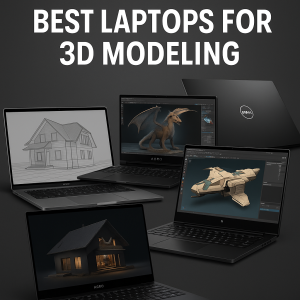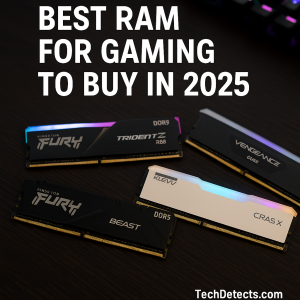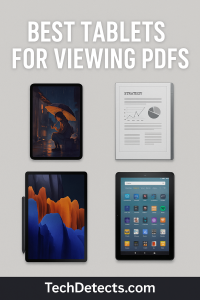Best Laptops for 3D Modeling (2025 Edition)
If you’re into 3D modeling, CAD, or rendering — your laptop needs more than average specs. These tasks demand high-performance CPUs, powerful GPUs, lots of RAM, and efficient thermal management. Whether you’re a student working on SolidWorks, a Blender artist, or an engineer running AutoCAD, choosing the right machine matters.

We’ve handpicked the best laptops for 3D modeling in 2025 — all verified to be real, currently available on Amazon, and built to handle intense workloads.
List of Best Laptops for 3D Modeling
Apple MacBook Pro 16″ (M4 Pro)
Specs: Apple M4 Pro, 16GB–64GB Unified RAM, 512GB–2TB SSD, 16.2″ Liquid Retina XDR Display
Short Review:
The 16‑inch MacBook Pro (M4 Pro) remains Apple’s most capable large‑screen laptop for 3D modeling and rendering today. It pairs the excellent XDR display with sustained performance and long battery life, making it a dependable choice for Blender and Cinema4D. While macOS still limits a few niche CAD applications, it’s outstanding for media professionals and 3D artists.
Pros:
Fast creative performance, superb HDR display, long battery life
Cons:
Limited compatibility with some CAD suites, premium pricing
Best For:
3D artists, animators, Final Cut/Blender users who want a larger 16‑inch canvas
Note: If you prefer a smaller chassis, Apple’s new 14‑inch MacBook Pro (M5) launched October 15, 2025, offers up to 20% faster multithreaded CPU and up to 1.6× faster graphics versus the previous 14‑inch model, plus faster storage and higher memory bandwidth. See our comparison: MacBook Pro M5 vs M4 – Apple’s AI Leap Compared.
👉 Buy on Macbook Pro M4 Amazon
👉 Buy on Macbook Pro M5 Amazon
Lenovo ThinkPad P16 Gen 2 (Intel + RTX 4000/5000 Ada)
Specs: Intel Core i9/i7, NVIDIA RTX 4000 or 5000 Ada, 32GB–128GB RAM, 1TB+ SSD
Short Review:
A mobile workstation built for real 3D professionals. ThinkPad durability, ECC memory support, and high-end RTX Ada GPUs make this ideal for engineering, 3D simulation, and rendering workflows.
Pros: ISV-certified, rugged build, expandable
Cons: Heavy, expensive
Best For: Engineers, architects, CAD professionals
Dell Precision 5690 (Intel + RTX A-Series)
Specs: Intel Core Ultra/i9, NVIDIA RTX A1000–A3000, 32GB+ RAM, 1TB SSD
Short Review:
Dell’s Precision line continues to impress. With powerful CPUs and pro-grade RTX GPUs, it’s tuned for reliability and certified for software like Revit, SolidWorks, and Maya.
Pros: Color-accurate screen, durable chassis, workstation-grade GPUs
Cons: Not ultralight, premium pricing
Best For: CAD work, 3D design, Revit/SolidWorks users
Asus ROG Zephyrus G14 (2025, Ryzen 9 + RTX 40-Series)
Specs: AMD Ryzen 9 8945HS, NVIDIA RTX 4070/4080, 16GB–32GB RAM, QHD+ 165Hz display
Short Review:
A compact powerhouse, the Zephyrus G14 is well-balanced for creators and gamers alike. It performs impressively in Blender and Unreal Engine, with strong thermals and mobility.
Pros: Lightweight, strong 3D performance, great display
Cons: Slight fan noise under load
Best For: Students, mobile creators, mid-level 3D work
HP ZBook Studio G10
Specs: Intel Core i9, NVIDIA RTX A-Series, 32GB+ RAM, DreamColor 4K screen option
Short Review:
A sleek but mighty machine, ideal for CAD and modeling software. HP’s ZBook line is ISV-certified for stability and designed for professionals needing color accuracy and GPU horsepower.
Pros: Beautiful display, powerful specs, pro certification
Cons: Expensive at higher configs
Best For: Creative professionals, CAD engineers
MSI Creator Z17 HX Studio
Specs: Intel Core i9 HX, NVIDIA RTX 4070, 32GB+ RAM, QHD+ display
Short Review:
NVIDIA Studio certification ensures this laptop excels at visual tasks. Strong thermal design and a premium metal build make it a true workhorse for 3D and video editing.
Pros: Great cooling, strong RTX GPU, sleek design
Cons: Pricey, heavier than gaming counterparts
Best For: Blender, 3ds Max, visual artists
Razer Blade 16 (RTX 4080/4090)
Specs: Intel Core i9, NVIDIA RTX 4080/4090, 32GB RAM, Dual-Mode Mini-LED 240Hz/QHD+ display
Short Review:
Gaming power meets creator functionality. Razer Blade 16 handles high-end rendering tasks with ease. Premium design, top-tier specs, and one of the best displays in its class.
Pros: Stunning display, performance beast, slim
Cons: Expensive, average battery
Best For: 3D artists who game, Unreal/Unity users
Gigabyte AERO 16 OLED
Specs: Intel Core i9, NVIDIA RTX 4070, 16″ 4K OLED, 32GB RAM
Short Review:
Color-accurate OLED screen and powerful internals make the AERO 16 ideal for modeling and visual design. Great thermals and a vibrant display push it ahead for color-sensitive work.
Pros: Vivid OLED, RTX power, sleek
Cons: OLED battery drain
Best For: Modeling + color work, Adobe/Autodesk users
🔍 Comparison Table
| Laptop | CPU/GPU | Best For |
|---|---|---|
| MacBook Pro M4 Pro | Apple Silicon | Creative modeling, rendering |
| MacBook Pro 14 (M5, 2025) | Apple M5 chip | Portable 3D work & AI-optimized design tasks |
| ThinkPad P16 Gen 2 | Intel + RTX Ada | Engineering, CAD, architecture |
| Dell Precision 5690 | Intel + RTX A-Series | Certified pro workflows |
| Asus Zephyrus G14 (2025) | Ryzen 9 + RTX 40 | Portability, students, creatives |
| HP ZBook Studio G10 | Intel + RTX A-Series | Professional 3D workflows |
| MSI Creator Z17 Studio | Intel + RTX 4080 | Blender, 3D art, heavy workloads |
| Razer Blade 16 | Intel + RTX 4080/90 | 3D + gaming hybrid users |
| Gigabyte AERO 16 OLED | Intel + RTX 4070 | Color-intensive modeling tasks |
🏁 Final Verdict
- Want the best balance of power and platform? Go for the MacBook Pro M4 Pro or ThinkPad P16 Gen 2.
- For creative and portability needs, Zephyrus G14 and Gigabyte AERO 16 shine.
- Professionals will love the ZBook Studio, Precision 5690, or MSI Creator Z17 for top-tier tasks.
- Gamers and creators? Razer Blade 16 blends both worlds beautifully.
❓ FAQ
Q: Do I need an RTX GPU for 3D modeling?
Yes. RTX (or Apple M-series GPU) acceleration improves rendering, viewport responsiveness, and real-time ray tracing in many apps.
Q: Is macOS good for 3D modeling?
Yes for Blender, Cinema4D, and video FX. But many CAD tools (like SolidWorks, Revit) favor Windows.
Q: How much RAM is needed?
16GB is a baseline. 32GB+ is ideal for complex scenes, multitasking, or rendering.
Q: Are gaming laptops good for modeling?
Yes—many include powerful GPUs and fast displays. But thermals, build, and ISV certifications can lag behind workstations.
Q: What display is best for modeling?
QHD or 4K with high color accuracy (sRGB/AdobeRGB coverage) is best. OLED and mini-LED are bonuses.






